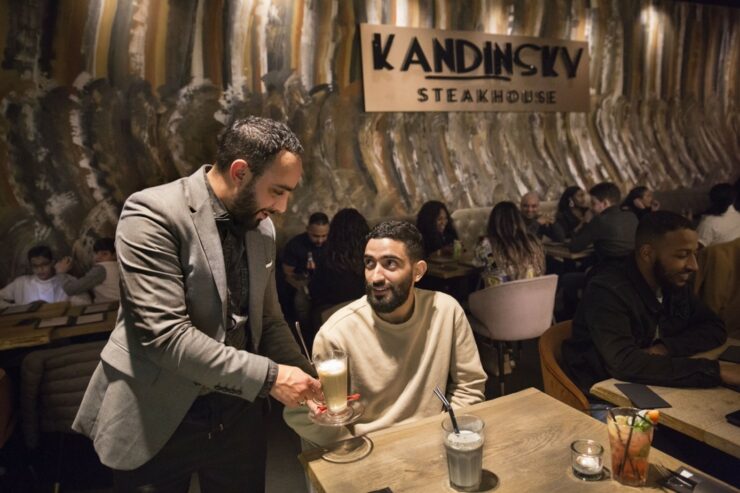As part of the project Religious Matters in an Entangled World, Margreet van Es studies the emergence of trendy, alcohol-free halal restaurants in Rotterdam. In this blog, she critically reflects on ‘rooted cosmopolitanism’, and introduces the term ‘multi-scalar cosmopolitanism’ as an analytical tool to gain a better understanding of the flows of people, ideas, and objects that allow people to experience cosmopolitanism in a particular setting.
What is cosmopolitanism, and how should we understand the cosmopolitan aspirations and practices of ordinary people? These are important questions in the social sciences and humanities today. Though being a much-disputed term, cosmopolitanism is usually defined in terms of an orientation of openness towards people and cultural practices from different parts of the world. For instance, the sociologist Gerard Delanty defines cosmopolitanism as ‘the creative interaction of cultures and the exploration of shared worlds.’[i] The anthropologist Pnina Werbner writes that ‘cosmopolitanism is about reaching out across cultural differences through dialogue, aesthetic enjoyment, and respect; of living together with difference.’[ii] As such, cosmopolitanism is not to be conflated with globalization or cultural hybridization: cosmopolitanism has a normative dimension that can be embraced or rejected. In everyday language, cosmopolitanism bears the connotation of being at home all over the world and of being free from local, provincial, or national attachments and prejudices. However, there is growing scholarly agreement that although many people may strive to be cosmopolitan, their aspirations are always rooted in culturally specific loyalties and understandings. Hence, the term ‘rooted cosmopolitanism’ is increasingly used to indicate, among other things, that there are many different cosmopolitanisms, each with its own history and distinctive worldview.[iii]
Cosmopolitanism also plays an important role in the allure of many alcohol-free halal restaurants that I study in Rotterdam as part of my research on the relationship between food, religious diversity, and coexistence. During my research, I have become more and more interested in the question of how different cosmopolitanisms exist side by side – and sometimes clash – in a superdiverse world port city such as Rotterdam. Here, Dutch people without a recent family history of immigration are only one numerical minority among many other minorities. Moroccan-Dutch and Turkish-Dutch Muslims are among the most well-established and stable inhabitants, having lived in the same city for two or three generations.[iv] As a result of the steep upward social mobility among young Muslims, pioneering Muslim entrepreneurs have started new, mid-priced restaurants where people can dine out in a comfortable and trendy interior, and where everything on the menu is halal. These restaurants vary from steakhouses to Tex-Mex eateries, and from lavish Ottoman restaurants to sushi bars.
A key question in my ongoing research is how aspirations of cosmopolitanism (as well as those of upward social mobility, Islamic piety, and more) are reproduced and become materialized in a particular restaurant, in a dynamic interaction between consumers, restaurateurs, their employees, and all sorts of material forms, such as the interior design and the items on the menu. My focusing on aspirations means that I study cosmopolitanism as a hopeful striving for something that can never be fully grasped. However, inspired by Birgit Meyer’s notion of the ‘sensational form’, I argue that the act of dining out allows certain aspirations to momentarily become ‘real’. Restaurants are, after all, ‘prime sites of designed experiences, collectively produced’.[v]
In this blog, I take the example of restaurant Da Vinci, located in the city center of Rotterdam. Until recently, it was known as Kandinsky Steakhouse, named after the Russian-French artist Wassily Kandinsky (1866–1944). In January 2022, the new owner renamed the restaurant after Leonardo Da Vinci (1452–1519).[vi] The restaurant has a large glass façade and a sleek interior design with black, gold, and marble details. The large wall on the left looks like a piece of abstract art, with big strokes of warm beige, orange-brown, and grey. Cosmopolitanism is all over the place. On the right wall near the entrance, eight clocks indicate the time in New York, Paris, Tokyo, Morocco, Istanbul, Dubai, Mexico, and London. The menu lists international dishes that are well-known in the Netherlands, but that are seldom available in a halal form, including beef tenderloin (served with grilled vegetables, fries, and coleslaw), spareribs (made from veal instead of pork), and pasta pesto with chicken. For many young Muslims who only want to eat meat if it is halal slaughtered, Da Vinci offers a welcome opportunity to broaden their culinary horizon. In addition to a variety of savory and sweet dishes, the restaurant serves soft-drinks and alcohol-free cocktails, the most popular being the virgin mojito. Alcoholic beverages are not served: the initial owner, a Moroccan-Dutch Muslim, did not want to earn his income based on the sales of haram items, and some of the patrons and staff also prefer it this way.

Throughout my research, I have repeatedly encountered the assumption that alcohol-free restaurants draw a one-sided crowd of pious Muslims. However, Da Vinci has a highly diverse patronship in terms of nationality and religious affiliation. Most of the regular customers have Moroccan roots. But on any random evening, diners may find themselves seated between a young Turkish-Dutch couple on their first date, a Surinamese-Dutch family, two middle-aged, white Dutch men in a long-term relationship, a group of six young males of Moroccan-Dutch, Cape-Verdean-Dutch, and Caribbean-Dutch descent who are celebrating a birthday, and a Moroccan-Belgian influencer who has travelled from Antwerp with a friend to create new content for her Instagram page. Not everyone is Muslim, and those who are, relate to their religion in different ways. In my conversations with the owners and staff, they always emphasized that they want to welcome a diverse crowd. This was not only a matter of commercial interests, but also of ethics. As restaurant manager Souhaib El Moussaoui says:
Everybody is welcome. The cultural diversity that is so typical for Rotterdam, we really want to radiate that. […] Nowadays, we have more and more Hindu customers with Surinamese roots. Many of them prefer chicken over beef, so we have put more chicken dishes on the menu.[vii]
The cultural diversity is also reflected among the staff, who trace their roots to Morocco, Turkey, and French Guyana, among other places. All the aforementioned elements together make cosmopolitanism tangible in the restaurant, and they allow people to see themselves as part of a larger community of modern and open-minded ‘citizens of the world’.

I consider the term ‘rooted cosmopolitanism’ to be useful to see the cosmopolitanism produced in restaurant Da Vinci as one out of many possible cosmopolitanisms in Rotterdam. Yet, my observations do not fully match with certain basic assumptions in contemporary scholarly debates and in wider society. When we think about cosmopolitanism, we tend to rely on a conceptual model of concentric circles of identification, from the microscopically local to the global (see below).[viii] The term ‘rooted’ then suggests that any form of ‘rooted cosmopolitanism’ has its base in one specific locality, from where people open themselves up to the world. But the cosmopolitanism produced in Da Vinci is not only rooted in Rotterdam, and the multiple international connections and influences that play a role in this process do not fit into a model of concentric circles.

When Souhaib El Moussaoui speaks warmly about ‘the cultural diversity that is so typical for Rotterdam’, cosmopolitanism is directly connected to a specific, local identity that people can be proud of. His comment does not come out of the blue. The Rotterdam municipality increasingly adopts cosmopolitanism as part of its city branding.[ix] And indeed, research shows that for many young inhabitants (especially those of Moroccan origins), having close friends of different nationalities and religious affiliations is a default situation that does not even need emphasis.[x] Although few of them explicitly refer to themselves as ‘cosmopolitans’, they tend to embrace the city of Rotterdam precisely because they see it as a ‘world city’ with a ‘beautiful mix of cultures’.[xi] What we see here is an interesting conflation of world citizenship and local pride.
Yet, the restaurant is as much ‘rooted’ in the Moroccan city of Tangier as it is in Rotterdam, and it can be seen as a product of a decades-long exchange of people, ideas, and objects between Morocco and the Netherlands. When the restaurant was established under the name Kandinsky Steakhouse, the idea was loosely based on restaurant Kandinsky Plaza in Tangier. Kandinsky Plaza caters mostly to European youth of Moroccan origins, and it has for a long time been a well-known pit stop for Moroccan-Dutch youth traveling to Morocco with their parents during the summer holidays.
However, for Kandinsky Steakhouse in Rotterdam, the initial owner also took inspiration from restaurants he had seen during his many travels across the world, especially steakhouses in Argentina and high-end halal restaurants in Dubai. The latter city has recently become a gravitation point for the cosmopolitan aspirations of many people across the world, including European Muslims.[xii] Initially, the restaurant also had a ‘wall of fame’ featuring ‘role models’ that added to the international allure of the restaurant. One of them was the former US president Barack Obama, and another one was the Turkish entrepreneur and global internet sensation Nusret Gökçe – also known as ‘Saltbae’ – who owns numerous Nusr-Et steakhouses across the world where the rich and famous enjoy gold-leaf-covered steaks and hamburgers. Finally, Kandinsky Steakhouse used the slogan ‘From the mountains – 2480 meters high’ to indicate that many of the ingredients used in the restaurant were directly imported from a mountainous region in Morocco.[xiii] This is an interesting celebration of rurality amidst the many references to urban modernity. All in all, I think that neither the term ‘rooted cosmopolitanism’, nor a model of concentric circles of identification fully do justice to this complex configuration of cross-cultural connections and influences.
Given the fact that some of the terms and conditions on which people are welcomed in the restaurant – halal meat, no alcoholic beverages – are related to aspirations of Islamic piety, one could perhaps speak in terms of a ‘Muslim’ or ‘Islamic’ cosmopolitanism. These concepts have been developed, among other reasons, to challenge the widespread assumption that cosmopolitanism is by default secular.[xiv] But the cosmopolitanism produced in restaurant Da Vinci is not simply a cosmopolitanism by and for practicing Muslims. It is also co-produced by the many patrons (whether Muslim or non-Muslim) who do not care whether the meat is halal or not, or who would enjoy a glass of wine with their steak. They happily join the crowd in pursuit of a tasty meal and a nice evening out, and they are open to being included on someone else’s terms and conditions. Thus, we should not reduce the restaurant’s cosmopolitanism to the fixed identity category of ‘Muslims’.
How should we then understand this eclectic mix of local cultural diversity, the generic internationality of the food being served, visual references to world cities as well as online celebrities, and the subtle and less subtle hints to Moroccan localities and transnational mobilities that enable a particular form of cosmopolitanism to become tangible in this restaurant? In my view, this can best be analyzed in terms of ‘multi-scalar cosmopolitanism’. I take the term ‘multi-scalar’ from Ayşe Çağlar’s and Nina Glick Schiller’s anthropological work on migrants and urban redevelopment.[xv] Çağlar and Schiller developed the concept of the multi-scalar to analyze how cities are situated in broader socio-spatial spheres of practice. Instead of assuming that people (as well as institutions and corporate entities) act on one specific ‘level’ or ‘scale’ (such as that of the city, the nation-state, or the world), they show how people always act within an ever-changing configuration of multiple and intersecting networks that sometimes extend locally, sometimes regionally, nationally, or cross-nationality, and that sometimes span the globe. All these networks are tied up with different hierarchies of power. Hence, Çağlar and Schiller invite scholars to look differently at the localities they study, and to observe in one location how seemingly independent processes and locations are interconnected.
My argument is that the concept of the ‘multi-scalar’ is also crucial to understand how cosmopolitan aspirations are reproduced and become materialized in restaurant Da Vinci, and to gain a better understanding of ‘lived’ cosmopolitanism more generally. In introducing the term ‘multi-scalar cosmopolitanism’, I aim to move beyond a model of concentric circles of identification, and to provide a new analytical tool to study the cosmopolitan aspirations and practices of ordinary people. Whether we focus on religious or non-religious people, migrants or non-migrants, ‘rooted cosmopolitanisms’ are not simply rooted in one specific locality. They are situated in multiple and intersecting networks that extend across different ‘scales’, and it is the flows of people, ideas and objects in these multi-scalar networks that enable people to experience particular forms of cosmopolitanism. How this plays out in different settings remains a topic for future research.

[i] Gerard Delanty, “Introduction: The Emerging Field of Cosmopolitanism Studies,” in Routledge Handbook of Cosmopolitanism Studies, ed. Gerard Delanty (Milton Park: Routledge, 2012), 1–7, there 6.
[ii] Pnina Werbner, “Introduction: Towards a New Cosmopolitan Anthropology,” in Anthropology and the New Cosmopolitanism, ed. Pnina Werbner (Oxford: Berg, 2008), 1–29, there 2.
[iii] See, for example: Kwame Anthony Appiah. 2005. The Ethics of Identity (Princeton: Princeton University Press, 2005); Werbner, “Introduction”.
[iv] Maurice Crul, Frans Lelie, and Elif Keskiner, “The Second and Third Generation in Rotterdam: Increasing Diversity within Diversity,” in Coming to Terms with Superdiversity: The Case of Rotterdam, eds. Peter Scholten, Maurice Crul, and Paul van de Laar (Cham: Springer Open, 2019), 57–71.
[v] Barbara Kirshenblat-Gimblett, “Foreword,” in Culinary Tourism, ed. Lucy M. Long (Lexington: The University Press of Kentucky, 2004), xi–xiv, there xii.
[vi] The initial owner and the current owner of the restaurant wish to remain anonymous. The initial owner was interviewed on 4 December 2019. The author has had multiple short conversations with the current owner between January 2021 and October 2022.
[vii] Souhaib El Moussaoui, interviewed on 24 September 2021. At the time of writing, Souhaib El Moussaoui was no longer working at Da Vinci.
[viii] Cf.: Werbner, “Introduction”.
[ix] Warda Belabas and Jasper Eshuis, “Superdiversity and City Branding: Rotterdam in Perspective,” in Coming to Terms with Superdiversity, eds. Scholten, Crul, and van de Laar, 209–223.
[x] Crul, Lelie and Keskiner, “The Second and Third Generation in Rotterdam”.
[xi] Marianne van Bochove and Jack Burgers, “Between Choice and Stigma: Identifications of Economically Successful Migrants,” in Coming to Terms with Superdiversity, eds. Scholten, Crul, and van de Laar, 73–83.
[xii] Jaafar Alloul, “Leaving Europe, Aspiring Access: Racial Capital and Its Spatial Discontents Among the Euro-Maghrebi Minority,” Journal of Immigrant and Refugee Studies 18, no. 3 (2020): 313–325.
[xiii] Among Moroccan-Dutch people, this implies that these ingredients are beldi – a Moroccan term that carries connotations of rural authenticity and organicity, and of not being industrially produced. See: Katharina Graf, “Beldi Matters: Negotiating Proper Food in Urban Moroccan Food Consumption and Preparation,” in Halal Matters: Islam, Politics and Markets in Global Perspective, eds. Florence Bergeaud-Blackler, Johan Fischer, and John Lever (London: Routledge, 2016), 72–90.
[xiv] See, for example: Kathryn Robinson,”Islamic Cosmopolitics, Human Rights, and Anti-Violence Strategies in Indonesia,” in Anthropology and the New Cosmopolitanism, ed. Pnina Werbner (Oxford: Berg, 2008), 111–133; Mara Leichtman and Dorothea Schulz, “Muslim Cosmopolitanism: Movement, Identity, and Contemporary Reconfigurations,” City & Society 24, no. 1 (2012): 1–6; Emma Tarlo, “Islamic Cosmopolitanism: The Sartorial Biographies of Three Muslim Women in London,” Fashion Theory 11, no. 2–3 (2015): 143–172; Khairudin Aljunied, Muslim Cosmopolitanism: Southeast Asian Islam in Comparative Perspective (Edinburgh: Edinburgh University Press, 2017).
[xv] Ayşe Çağlar and Nina Glick Schiller, Migrants & City-Making: Dispossession, Displacement, and Urban Regeneration (Durham: Duke University Press, 2018).

